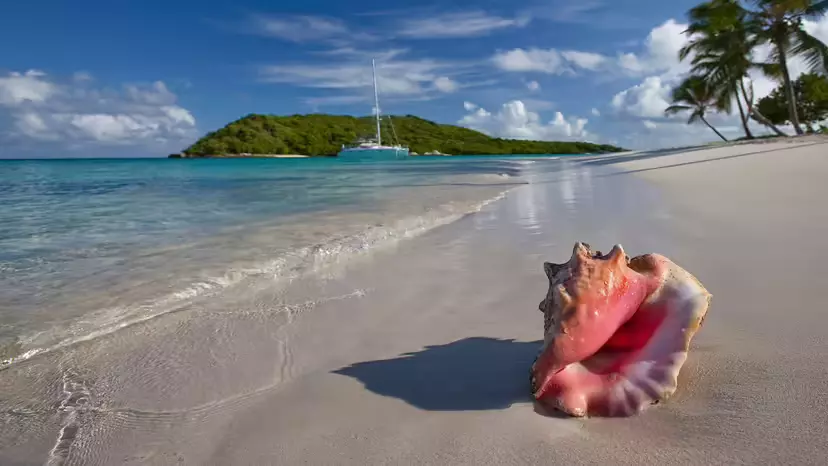Common names: Queen conch, pink conch
Scientific name: Lobatus gigas (formerly Strombus gigas)
Type: Marine gastropod (sea snail)
Range: Tropical western Atlantic—Bahamas, Bermuda, Florida Keys (US), U.S. Virgin Islands, Greater & Lesser Antilles, parts of Central/South America
Conservation: Heavily overfished; trade controlled under CITES (Appendix II); strict local rules in many places (e.g., Florida bans taking live conch)

“Conch” refers to several large marine snails, but the queen conch is the iconic species with a huge spiral shell and a glossy pink to orange interior. Inside lives a soft-bodied mollusk that moves with a muscular foot (often tipped with a hard “horn,” or operculum) that helps it crawl and right itself on sandy seafloors and seagrass beds.
Shell uses: Historically carved as signal horns, jewelry, and ornaments.
Meat: A staple food across the Caribbean (salads, fritters, chowders), making the species both culturally important and commercially valuable.
Queen conch are slow maturing and long-lived (up to ~40 years if protected). That pace makes them easy to overharvest before they can reproduce.
Typical timeline (simplified):
Year 1: Tiny juveniles bury in sand, hiding from predators.
Year 2: Emerge and roam seagrass, still highly vulnerable.
Year 3: Shell grows longer and thickens; survival improves.
Years 4–5: Sexual maturity if growth is uninterrupted.
Reproduction: Females lay egg masses (~hundreds of thousands of eggs); larvae drift for ~3 weeks before settling in nursery grounds.
How to tell maturity:
A fully mature conch has a flared, thick shell lip. A thin, paper-like lip = immature. Modern science and many rules use a lip thickness threshold (~15 mm / ~½ inch) to indicate sexual maturity.
Overfishing & early harvest: Immature conch are often taken before they’ve reproduced, rapidly draining breeding adults.
Allee effect (too few to find mates): When densities drop, conch struggle to locate each other, even if fishing stops.
Poaching & weak enforcement: Rules can be strong on paper but uneven in practice, and cross-border trade complicates oversight.
Habitat & pollution pressures: Seagrass loss, coastal development, warming seas, and contaminants add stress.
Trade pressure: The species is on CITES Appendix II—not “banned,” but international trade is regulated to prevent endangerment.
Conch are key herbivores in seagrass meadows. In healthy numbers they:
Graze algae & detritus, helping seagrass grow (vital nurseries for fish, turtles, invertebrates).
Feed predators (fish, crabs, lobsters, turtles), linking lower and higher parts of the food web.
Lose conch, and seagrass health declines, dragging many reef-associated species with it.
Maturity-based harvest: Enforce lip-thickness minimums, not just shell length.
Seasonal closures & quotas: Stop fishing when science-based limits are reached.
Nursery ground protection: Safeguard shallow, sandy seagrass beds where juveniles shelter.
No-take zones & marine reserves: Let breeder stocks rebuild and spill over.
Tighter trade controls: Proper CITES permitting; crack down on illegal export/import.
Community monitoring & alternative livelihoods: Engage fishers in surveys, patrols, and tourism; support gear buy-backs or job diversifications.
Consumer education: Encourage buyers to choose mature conch only (thick shell lip) from legal, verifiable sources—or skip it when in doubt.
If you’re traveling or shopping:
Don’t take live conch or fresh shells—it’s illegal in many places (e.g., Florida). People are fined or jailed for this.
Avoid buying new conch shells or trinkets unless the origin is legal and documented (and imports allowed).
If choosing conch to eat, ask to see the shell (or certification) and confirm a thick flared lip—a simple proxy for maturity.
Consider conch-free menu options where stocks are depleted.
Shell: Large, heavy, with spines and a flared lip in adults; interior pink/orange nacre.
Foot & operculum: Strong crawling organ; the operculum helps digging and flipping.
Habitat: Seagrass meadows, sandy plains, patch reefs at shallow to moderate depths.
Is it legal to collect conch shells from the beach?
Often no, especially if any tissue remains or you take a live animal. Laws vary by country/territory, but Florida prohibits taking queen conch and importing shells from certain places. When in doubt, leave it.
How do conch support seagrass?
By grazing algae and detritus, conch free seagrass leaves from smothering films, improving light and growth—benefiting a host of juvenile fishes and invertebrates.
Why isn’t length alone a good maturity test?
Because conch can grow long shells before maturity. The thick, flared lip develops later and is a better indicator that the animal has reached breeding age.
animal tags: queen conch
We created this article in conjunction with AI technology, then made sure it was fact-checked and edited by a Animals Top editor.